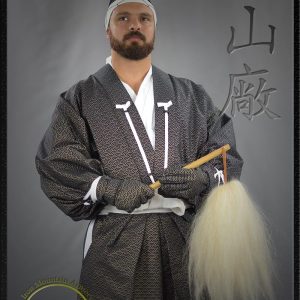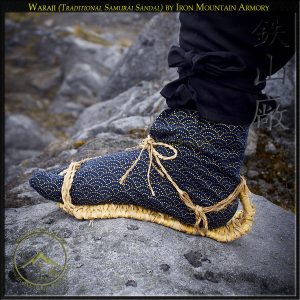- Traditionally Handcrafted
- Best Price Guarantee
- World wide delivery
$39.99 Original price was: $39.99.$29.95Current price is: $29.95. $29.95
Waraji Gake Tabi (Warabi kaki 草鞋掛け) are a traditional Japanese tabi (2 toe sock) cut from cotton linen that are to be worn together with the Waraji Sandals (traditional straw sandals). A new pair of waraji sandals can be a little hard and/or itchy on the feet, until they break in, and this pair of gake socks makes wearing them more comfortable. The Waraji Gake Tabi Socks date back to the 15th century or earlier. They are typically ankle-high and with a separation between the big toe and the others (2 toe). They are traditionally worn with waraji (straw sandals), zori (flat sandals), and geta (platform clogs), as well as other traditional tonged footwear. Gake-Tabi are essential with kimono and other wafuku (traditional Japanese clothing) as well as being worn by samurai and perhaps shinobi (ninja) in the feudal Sengoku Era.
Iron Mountain Armory hand makes these traditional samurai toe socks from quality asa (hemp or cotton linen), similar to what was used during the late Sengoku to late Edo era. These traditional tabi are perfect for the modern martial artists, re-enactors, cosplay, larp, sca and for those just wanting to add a bit of traditional style to their modern life. Custom sizing and materials help make your traditional samurai socks special and unique to you and/or group. Many martial artists are finding wearing waraji gake-tabi helps bring focus to their footing and makes a great traditional accessory to their traditional hakama. We do offer a modern poly cotton material to help for a better and more snug fit.
Ordering Tips: The Waraji Gake-Tabi are snug fittings without stretch, so we recommend adding at least 1.5 ~ 2 cm to your actual measurements for a more comfortable fit.
Features:
[table id=236 /]
Accessories:
[table id=PF /]
Our traditional tabi and other samurai clothing and accessories are featured in many movies, tv series, documentaries, including the docudrama “Age of Samurai: Battle for Japan” by Netflix, TLC, History & the Smithsonian Channel.
References: Wikipedia


